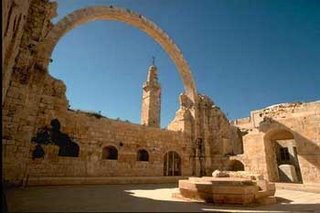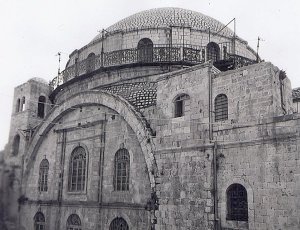
This was on Haaretz just yesterday. It talks about the archaeology that they have found as they renovate the Hurva shul in the Old City. I always get a real thrill as we understand that as we walk through the Jewish Quarter, just a few metres under our feet is a whole undiscovered world of a Kohanim's Quarter from Bayit Sheni. In this excavation, they have even discovered finds from Bayit Rishon!
"The excavations, which began in 2003, also unearthed structures and pottery from the First Temple period, remnants of rooms from the Herodian period (Second Temple), burnt wooden logs (evidence of fire that took place after the destruction of the Second Temple), and three plastered ritual baths carved in rock from the Second Temple period. The diggers also found a small weapons arsenal, where defenders of the Jewish Quarter stashed mortar shells and grenades during the Independence War. "
The land Hurva shul was originally purchased by Rabbi Yehuda HaHassid, in the year 1700. It was meant to house living accommodations and a shul/Beit Midrash for his followers. However the buildings there were destroyed by the arabs as the Jews could not pay the loans they took to buy it. Hence the name, the Hurva. After the Talmidei HaGra made Aliya in the 1840's they built the grandest shul on the site, and it became the "Great Synagogue" of Jerusalem, it's largest and grandest shul.


And the Jordanians blew it up in 1948 leaving it as a ruin.
So here is what I would like to relate to: It is fascinating to think about the mindset of the renovation of the Rova after 1967 when we regained control of the Old City. Teddy Kollek and the other planners envisioned the Old City as an Artists Colony, an exotic place with musicians and artisans. The scenery and streets, museums and squares would also remember and recall the past. But in this context, all the shuls; the Tiferet Yisrael, and the Hurva, the grandest structures, were left in ruins. It was a very secular modern view that prevailed with Synagogues left as Historical relics of a bygone age, a museum of sorts, a lost history alongside the Cardo and the Herodian stones, consigned to ancient History.
But of course, as religious people, we see Judaism in the present. It is not a romantic past-tense but a reality of the here and now. Nowadays the Jewish Quarter is predominantly populated by the religious. Why did the chilonim move out. Well - the difficulties of living in the Old City – difficult access, close proximity to many Arabs, endless tourists – have kept away the artists. But or the religious, the notion of the proximity to Makom Hamikdash speaks with resounding power. And so, the shuls are being rebuilt and an ancient glory is being restored. The wrongs of History are being pput right!
No comments:
Post a Comment